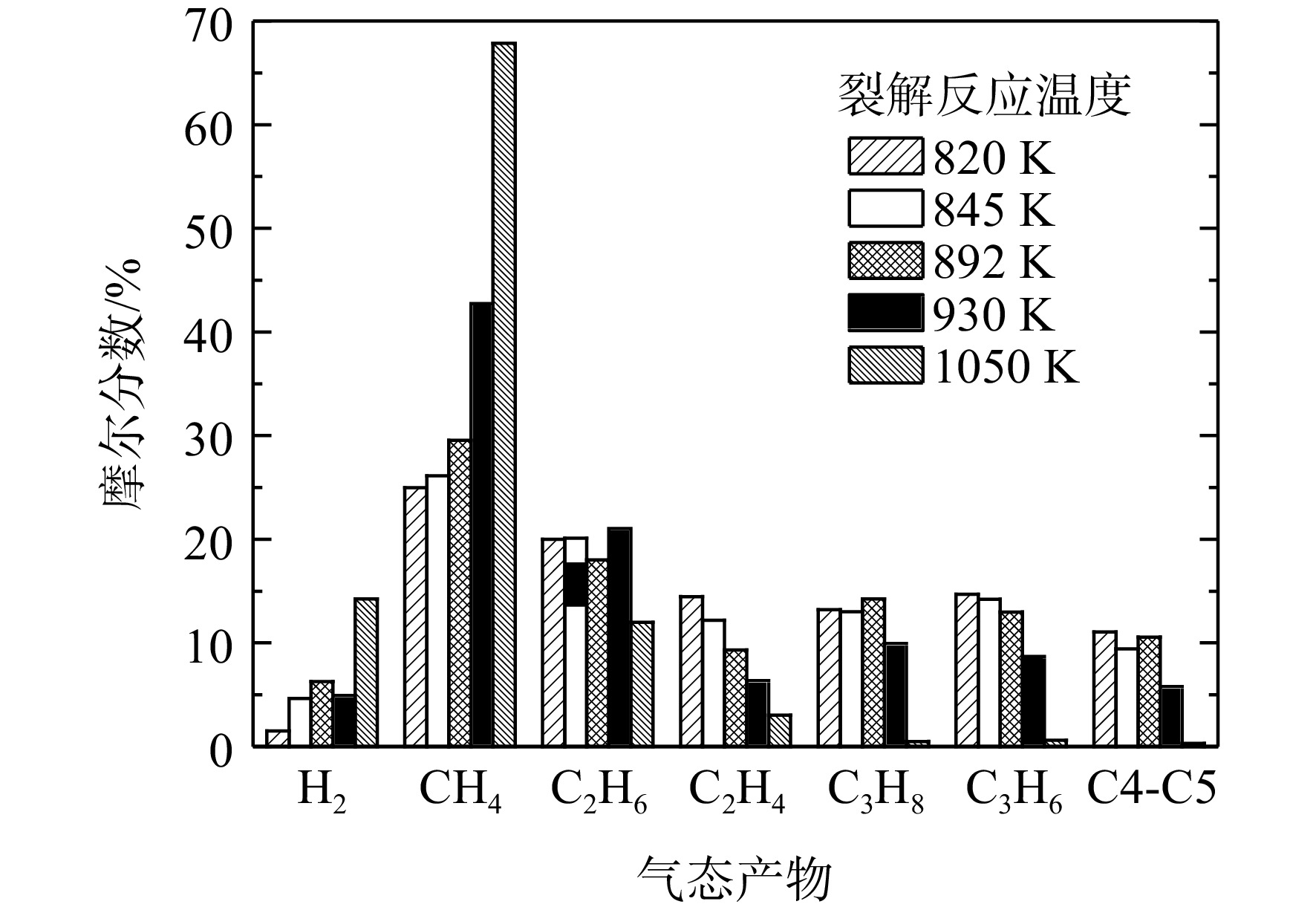Detonation-initiation characteristics of the bi-component mixture fuel
-
摘要:
在爆震燃烧中,与液态燃料相比气态燃料具有更好的起爆性能和可爆极限。在一定温度和压力下,液态碳氢燃料燃烧伊始发生的吸热裂解反应会产生小胞格尺寸的轻质气态小分子,其混合物组合可有效降低可燃混合物的临界起爆能量并提升燃料整体的起爆性能。研究液态燃料裂解反应中气态产物组分及含量对缓燃向爆震转变过程时间及距离的影响规律,有助于掌握形成易爆混合物的条件,指导液态燃料爆震燃烧室的设计。本文采用光学测量方法,对RP-3航空煤油热裂解反应的主要产物双组分气态燃料的起爆性能进行了实验研究,对不同组分燃料的起爆过程中火焰传播速度进行对比。结果表明:生成的甲烷摩尔分数大于60%时不能实现爆震起爆,烯烃类等气态不饱和烃可增强混合燃料的起爆性能。同时,适当地提高当量比,可以扩大混合燃料的可爆极限。
-
关键词:
- 脉冲爆震 /
- 起爆特性 /
- 双组分燃料 /
- 火焰传播速度 /
- DDT(缓燃向爆震转变)距离
Abstract:Compared with the gaseous fuels, liquid fuels have better detonability and wider explosive limits. Endothermic cracking reactions of a liquid hydrocarbon fuel occurring at the beginning of combustion under specific temperature and pressure can produce lighter gaseous fuels with a smaller cell size, which has the potential of dramatically reducing the critical initiation energy of the mixture and increasing its detonability. Study on the influence of the gaseous product components and content from the liquid fuel cracking reactions on the deflagration-to-detonation transition (DDT) time and DDT distance was carried out to help obtain better operation condition for generating more detonable mixtures and guide the design of detonation combustion chambers for liquid fuels. An experimental study on the detonation-initiation characteristics of bi-component gaseous fuel acquired from the products of RP-3 aviation kerosene thermal cracking reactions was also conducted via optical method. A comparison of flame propagation velocity in the process of detonation-initiation with different component fuels was carried out. The results showed that the detonation may fail when the methane molar fraction was greater than 60%, and the gaseous unsaturated hydrocarbons such as olefins can enhance the deniability of the mixture fuel. Meanwhile, increasing the equivalence ratio appropriately can enlarge the explosive limit of the mixture fuel.
-
表 1 乙烯爆震燃烧工况
Table 1. Working condition of C2H4 detonation
序号 温度/K 压力/kPa 当量比φ 1 293 95 1.1 2 293 95 1.2 3 293 95 1.3 4 293 95 1.4 -
[1] NICHOLLS J A,WILKINSON H R,MORRISON R B. Intermittent detonation as a thrust-producing mechanism[J]. Journal of Jet Propulsion,1957,27(5): 534-541. doi: 10.2514/8.12851 [2] PARETE-KOON S T,SMITH C R,PAPATHEODORE T L,et al. A review of direct numerical simulations of astrophysical detonations and their implications[J]. Frontiers of Physics,2013,8(2): 189-198. doi: 10.1007/s11467-013-0279-y [3] KAILASANATH K,SCHWER D A. High-fidelity simulations of pressure-gain combustion devices based on detonations[J]. Journal of Propulsion and Power,2017,33(1): 153-162. doi: 10.2514/1.B36169 [4] JIN Le,FAN Wei,WANG Ke,et al. Review on the recent development of multi-mode combined detonation engine[J]. International Journal of Turbo & Jet-Engines,2013,30(3): 303-312. [5] LU F,CARTER D,WILSON D. Development of a large pulse detonation engine demonstrator: AIAA2011-5544[R]. Reston,US: AIAA,2011. [6] KAILASANATH K. Research on pulse detonation combustion systems: a status report: AIAA2009-631[R]. Reston,US: AIAA,2009. [7] KAILASANATH K. Review of propulsion applications of detonation waves[J]. AIAA Journal,2000,38: 1698-1708. doi: 10.2514/2.1156 [8] EDWARDS T. Liquid fuels and propellants for aerospace propulsion: 1903-2003[J]. Journal of Propulsion and Power,2003,19(6): 1089-1107. doi: 10.2514/2.6946 [9] KANESHIGE M,SHEPHERD J E. Detonation database: FM97-8 [R]. Pasadena,US: California Institute of Technology,1997. [10] FAN Wei,YAN Chuanjun,HUANG Xiqiao,et al. Experimental investigation on two-phase pulse detonation engine[J]. Combustion and Flame,2003,133(4): 441-450. doi: 10.1016/S0010-2180(03)00043-9 [11] BROPHY C M,HETZER D,FORSTER L D. Detonation studies of JP-10 with oxygen and air for pulse detonation engine development: AIAA1998-4003 [R]. Reno,US: AIAA,1998. [12] KNYSTAUTAS R. Measurements of cell size in hydrocarbon-air mixtures and predictions of critical tube diameter,critical initiation energy,and detonability limits[C]//Dynamics of Shock Waves,Explosions,and Detonations. New York: AIAA,1985: 23-37. [13] SCHAUER F,MISER C,TUCKER C,et al. Detonation initiation of hydrocarbon-air mixtures in a pulsed detonation engine: AIAA2005-1343[R]. Reston,US: AIAA,2005. [14] FICKETT W,DAVIS W C. Detonation: theory and experiment[M]. New York: Dover Publications Incorporated,1979. [15] COOPER M,SHEPHERD J. Experiments studying thermal cracking,catalytic cracking,and pre-mixed partial oxidation of JP-10: AIAA2003-4687 [R]. Reston,US: AIAA,2003. [16] HELFRICH T,SCHAUER F,BRADLEY R,et al. Evaluation of catalytic and thermal cracking in a JP-8 fueled pulsed detonation engine: AIAA2007-235[R]. Reno,US: AIAA,2007. [17] HELFRICH T,SCHAUER F,BRADLEY R,et al. Ignition and detonation-initiation characteristics of hydrogen and hydrocarbon fuels in a PDE: AIAA2007-234[R]. Reno,US: AIAA,2007 . [18] AUSTIN J M,SHEPHERD J E. Detonations in hydrocarbon fuel blends[J]. Combustion and Flame,2003,132(1/2): 73-90. [19] SHAMSHIN I O,KAZACHENKO M V,FROLOV S M,et al. Transition of deflagration to detonation in ethylene-hydrogen-air mixtures[J]. International Journal of Hydrogen Energy,2022,47(37): 16676-16685. doi: 10.1016/j.ijhydene.2022.03.158 [20] ZHANG Yun,CHENG Yangfan,SU Jian,et al. Experimental investigation on the near detonation limits of propane/hydrogen/oxygen mixtures in a rectangular tube[J]. International Journal of Hydrogen Energy,2020,45(1): 1107-1113. doi: 10.1016/j.ijhydene.2019.10.249 [21] SHAMSHIN I O,KAZACHENKO M V,FROLOV S M,et al. Deflagration-to-detonation transition in stochiometric mixtures of the binary methane-hydrogen fuel with air[J]. International Journal of Hydrogen Energy,2021,46(68): 34046-34058. doi: 10.1016/j.ijhydene.2021.07.209 [22] ZHANG Bo. Detonation limits in methane-hydrogen-oxygen mixtures: dominant effect of induction length[J]. International Journal of Hydrogen Energy,2019,44(41): 23532-23537. doi: 10.1016/j.ijhydene.2019.07.053 [23] ZHANG Bo,PANG Lei,GAO Yuan. Detonation limits in binary fuel blends of methane/hydrogen mixtures[J]. Fuel,2016,168: 27-33. doi: 10.1016/j.fuel.2015.11.073 [24] ZHANG Bo,PANG Lei,SHEN Xiaobo,et al. Measurement and prediction of detonation cell size in binary fuel blends of methane/hydrogen mixtures[J]. Fuel,2016,172: 196-199. doi: 10.1016/j.fuel.2016.01.034 [25] ZHONG Fengquan,FAN Xuejun,YU Gong,et al. Thermal cracking and heat sink capacity of aviation kerosene under supercritical conditions[J]. Journal of Thermophysics and Heat Transfer,2011,25(3): 450-456. doi: 10.2514/1.51399 [26] MOHRI K,GÖRS S,SCHÖLER J,et al. Instantaneous 3D imaging of highly turbulent flames using computed tomography of chemiluminescence[J]. Applied Optics,2017,56(26): 7385-7395. doi: 10.1364/AO.56.007385 [27] MICKA D J,DRISCOLL J F. Combustion characteristics of a dual-mode scramjet combustor with cavity flameholder[J]. Proceedings of the Combustion Institute,2009,32(2): 2397-2404. doi: 10.1016/j.proci.2008.06.192 [28] SHIN D H,PLAKS D V,LIEUWEN T,et al. Dynamics of a longitudinally forced,bluff body stabilized flame[J]. Journal of Propulsion and Power,2011,27(1): 105-116. doi: 10.2514/1.48056 [29] EMERSON B,MONDRAGON U,ACHARYA V,et al. Velocity and flame wrinkling characteristics of a transversely forced,bluff-body stabilized flame,part I: experiments and data analysis[J]. Combustion Science and Technology,2013,185(7): 1056-1076. doi: 10.1080/00102202.2013.777714 [30] 吴石林,张玘. 误差分析与数据处理[M]. 北京: 清华大学出版社,2010. [31] CAMARDO L,KING P,STEVENS C,et al. Determination of effective crossover location and dimensions for branched detonation in a pulsed detonation engine: AIAA2012-122[R] Reston,US: AIAA,2012. [32] LI Quan,KELLENBERGER M,CICCARELLI G. Geometric influence on the propagation of the quasi-detonations in a stoichiometric H2-O2 mixture[J]. Fuel,2020,269: 117396. doi: 10.1016/j.fuel.2020.117396 [33] ZHANG Bo,LIU Hong,LI Yuanchang. The effect of instability of detonation on the propagation modes near the limits in typical combustible mixtures[J]. Fuel,2019,253: 305-310. doi: 10.1016/j.fuel.2019.05.006 [34] LEE J H S. The detonation phenomenon[M]. Cambridge,UK: Cambridge University Press,2008. -








 下载:
下载:











